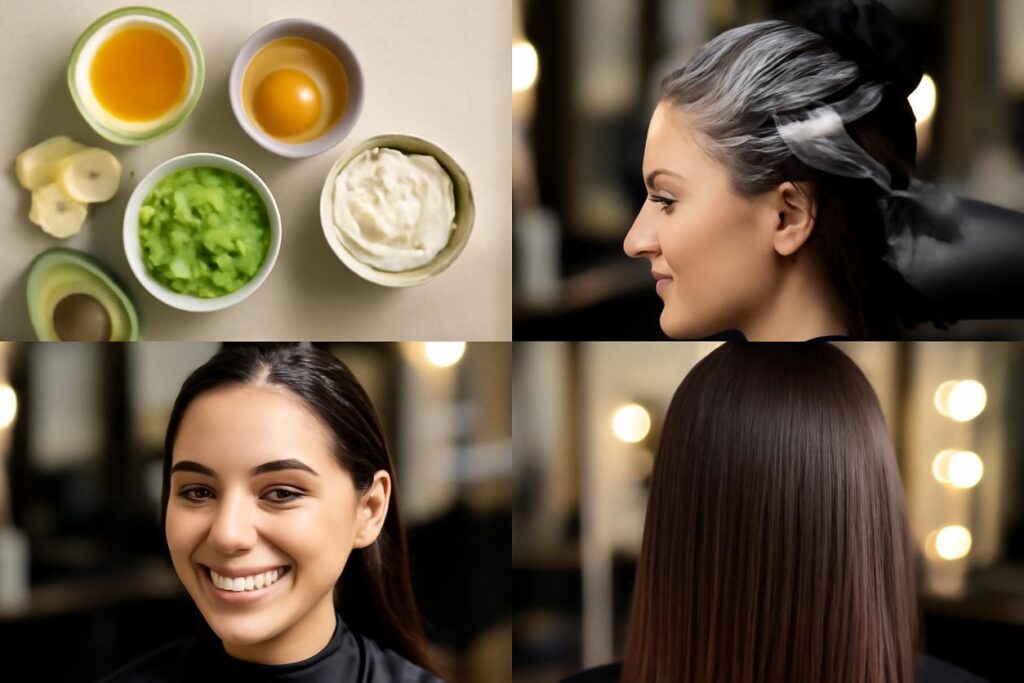Unlock Your Hair’s Potential: A Practical Guide to Home Remedies for Hair Growth
Table of Contents
- Introduction: A Realistic Approach to Natural Hair Growth
- Why Is My Hair Growing So Slowly?
- How Can Home Remedies for Hair Growth Actually Help?
- Top Kitchen-Tested Home Remedies for Hair Growth
- Preparation and Application: A Step-by-Step Guide
- Safety First: Patch Testing and Precautions
- Fueling Growth from Within: Essential Foods and Vitamins
- Beyond Remedies: Daily Habits for Thicker, Stronger Hair
- Your 7-Day At-Home Hair Growth Plan for 2025
- When to See a Doctor or Trichologist
- Frequently Asked Questions (FAQ)
- Sources and Further Reading
- Quick Reference Guide: Recipes and Timings
Introduction: A Realistic Approach to Natural Hair Growth
Searching for ways to encourage hair growth can feel overwhelming. The internet is flooded with quick-fix promises and miracle cures. This guide is different. We’re cutting through the noise to bring you a practical, science-backed approach to using home remedies for hair growth. Forget complex, expensive ingredients; we’re heading straight to your kitchen.
This article focuses on what truly works: simple, accessible ingredients, the science behind why they are effective, and a realistic routine you can start today. We combine topical treatments with the foundational importance of nutrition and healthy habits, giving you a holistic plan for nurturing your hair from root to tip. This is your go-to manual for supporting your hair’s natural growth cycle effectively and affordably.
Why Is My Hair Growing So Slowly?
Before diving into remedies, it’s helpful to understand why your hair might not be growing as quickly as you’d like. Hair growth occurs in a cycle with three main phases: anagen (growth), catagen (transition), and telogen (resting). The length of the anagen phase determines how long your hair can grow. Several factors can shorten this phase or weaken the hair follicle:
- Genetics: Your DNA is the primary blueprint for your hair’s thickness, texture, and growth rate.
- Stress: High levels of stress can push hair follicles prematurely into the resting phase, leading to increased shedding.
- Nutritional Deficiencies: Hair follicles require a steady supply of vitamins and minerals to build strong hair. A lack of iron, zinc, or biotin can stunt growth.
- Hormonal Fluctuations: Changes related to pregnancy, menopause, or thyroid issues can significantly impact the hair growth cycle.
- Scalp Health: An unhealthy scalp—whether it’s dry, oily, or has a lot of buildup—can clog follicles and inhibit new growth.
- Physical Damage: Over-styling with heat, tight hairstyles, and harsh chemical treatments can cause breakage, making it seem like your hair isn’t growing.
How Can Home Remedies for Hair Growth Actually Help?
While home remedies won’t change your genetics, they can create the optimal environment for your hair to thrive. They work by addressing many of the issues listed above. Effective home remedies for hair growth primarily focus on:
- Improving Scalp Circulation: Massaging remedies into the scalp boosts blood flow, delivering more oxygen and nutrients to the hair follicles.
- Providing Key Nutrients: Ingredients rich in vitamins, minerals, and antioxidants can directly nourish the scalp and hair shafts.
- Reducing Inflammation and Buildup: Many natural ingredients have anti-inflammatory and antimicrobial properties that help cleanse the scalp and keep follicles clear.
- Strengthening Hair Strands: Certain oils and masks can penetrate the hair shaft to reduce protein loss, minimizing breakage and helping you retain length.
Top Kitchen-Tested Home Remedies for Hair Growth
These remedies use simple ingredients you likely already have. They are celebrated for their potent properties that support a healthy scalp and robust hair.
Aloe Vera: The Scalp Soother
Benefit: Aloe vera is a fantastic scalp conditioner. It contains proteolytic enzymes that break down dead skin cells and product buildup, which can clog hair follicles. Its soothing properties also help calm an itchy or irritated scalp.
The Science: Aloe’s moisturizing properties and nutrient-rich composition (vitamins A, C, and E) create a healthy environment for hair follicles to function optimally.
Rosemary Oil: The Circulation Booster
Benefit: A star player in natural hair care, rosemary oil is believed to stimulate hair growth by improving circulation to the scalp and delivering more oxygen to follicles. Some studies suggest it may be as effective as minoxidil for certain types of hair loss.
The Science: Carnosic acid, an active ingredient in rosemary, is thought to heal nerve endings in the scalp, which can help rejuvenate follicles and encourage growth.
Onion Juice: The Sulphur Powerhouse
Benefit: Though the smell is potent, the results can be worth it. Onions are rich in dietary sulphur, a crucial component of keratin—the protein hair is made of. Applying it topically can provide extra sulphur to support strong, thick hair.
The Science: The sulphur in onion juice may help promote collagen production. Collagen contributes to healthier skin cells on the scalp and robust hair follicles.
Coconut Oil: The Protein Protector
Benefit: Coconut oil is one of the few oils that can penetrate the hair shaft. Used as a pre-wash treatment, it helps reduce the protein loss that occurs during washing and styling, leading to less breakage and stronger strands.
The Science: The lauric acid in coconut oil has a high affinity for hair proteins, allowing it to bind to the hair and protect it from damage from the inside out.
Green Tea: The Antioxidant Rinse
Benefit: The antioxidants in green tea, particularly a catechin called EGCG (epigallocatechin gallate), can help protect your hair follicles from damage caused by free radicals.
The Science: EGCG can help stimulate hair follicles and may prevent damage to skin and hair cells. A simple green tea rinse can soothe the scalp and add shine.
Preparation and Application: A Step-by-Step Guide
Here’s how to prepare and use a simple yet effective scalp treatment.
Rosemary Oil and Coconut Oil Scalp Massage
- Gather Your Ingredients: You will need 2 tablespoons of a carrier oil (like melted coconut or jojoba oil) and 3-5 drops of high-quality rosemary essential oil.
- Mix a Small Batch: In a small bowl, combine the carrier oil and rosemary essential oil. Never apply undiluted essential oils directly to your scalp.
- Section Your Hair: Part your dry hair into several sections to ensure you can easily access your entire scalp.
- Apply and Massage: Dip your fingertips into the oil mixture and apply it directly to your scalp. Use gentle, circular motions to massage the oil in for 5-10 minutes. This massage is key to stimulating blood flow.
- Let It Sit: Leave the oil treatment on for at least 30 minutes. For deeper conditioning, you can leave it on for a few hours or even overnight with a shower cap.
- Wash It Out: Shampoo and condition your hair as usual. You may need to shampoo twice to remove all the oil residue. Repeat this treatment 1-2 times per week.
Safety First: Patch Testing and Precautions
Even natural ingredients can cause irritation or allergic reactions. Before applying any new remedy to your entire scalp, perform a patch test.
- Apply a small amount of the prepared mixture to a discreet area of skin, like behind your ear or on your inner elbow.
- Wait 24 hours.
- If you experience any redness, itching, or irritation, do not use the remedy.
Always be careful to avoid getting these mixtures in your eyes. If contact occurs, rinse thoroughly with cool water.
Fueling Growth from Within: Essential Foods and Vitamins
Topical treatments are only part of the story. What you eat provides the building blocks for healthy hair. Ensure your diet is rich in the following:
- Biotin: Found in eggs, almonds, and sweet potatoes. Biotin is essential for producing keratin.
- Iron: Iron deficiency is a major cause of hair loss. Load up on spinach, lentils, and red meat.
- Vitamin C: This vitamin helps your body absorb iron and is crucial for creating collagen. Find it in citrus fruits, bell peppers, and strawberries.
- Protein: Since hair is made of protein, a sufficient intake is non-negotiable. Lean meats, fish, beans, and Greek yogurt are excellent sources.
- Zinc: This mineral plays a vital role in hair tissue growth and repair. It’s found in oysters, pumpkin seeds, and chickpeas.
Beyond Remedies: Daily Habits for Thicker, Stronger Hair
Incorporate these simple habits into your routine to minimize breakage and support the effects of your home remedies.
- Gentle Detangling: Always detangle your hair from the ends up to the roots using a wide-tooth comb, especially when it’s wet and most fragile.
- Scalp Massage: Even on days you don’t do an oil treatment, a 5-minute scalp massage can boost circulation.
- Reduce Heat Styling: Give your hair a break from blow dryers, straighteners, and curling irons whenever possible.
- Avoid Tight Hairstyles: Constant pulling from tight ponytails or buns can cause traction alopecia, a type of hair loss.
- Protect Your Hair: Wear a hat in the sun and use a silk or satin pillowcase to reduce friction and breakage while you sleep.
Your 7-Day At-Home Hair Growth Plan for 2025
Here is a sample weekly schedule to kickstart your journey with home remedies for hair growth. Adjust it to fit your lifestyle.
| Day | Activity | Focus |
|---|---|---|
| Day 1 | Gentle Scalp Massage | Boost circulation without product. |
| Day 2 | Nutrient-Rich Meal Prep | Focus on hair-healthy foods like salmon, spinach, and nuts. |
| Day 3 | Coconut Oil Pre-Wash Treatment | Deep condition and protect hair strands before washing. |
| Day 4 | Rest Day | Let your hair rest in a loose, low-manipulation style. |
| Day 5 | Aloe Vera Scalp Mask | Soothe and cleanse the scalp. |
| Day 6 | Protective Styling | Wear your hair in a loose braid or bun to prevent breakage. |
| Day 7 | Gentle Wash and Green Tea Rinse | Cleanse your hair and finish with a strengthening antioxidant rinse. |
When to See a Doctor or Trichologist
Home remedies are excellent for supporting overall hair health, but they are not a cure for underlying medical conditions. You should consult a healthcare professional or a certified trichologist (a hair and scalp specialist) if you experience:
- Sudden or excessive hair shedding.
- Bald patches.
- Scalp pain, severe itching, or scaling.
- Hair loss accompanied by other symptoms like fatigue or weight changes.
Frequently Asked Questions (FAQ)
How long does it take to see results from home remedies?
Patience is key. Hair grows about half an inch per month on average. With consistent use of remedies and healthy habits, you may start to notice improvements in scalp health and hair texture within a few weeks, but visible new growth can take 3 to 6 months.
Can I mix different home remedies for hair growth?
It’s best to introduce one new remedy at a time to see how your scalp reacts. Once you know you don’t have a sensitivity, you can combine ingredients with complementary benefits, such as adding a few drops of rosemary oil to an aloe vera gel mask.
Are these remedies safe for color-treated hair?
Most of these remedies, like coconut oil and aloe vera, are generally safe. However, ingredients like onion juice or highly acidic substances could potentially affect hair color. Always perform a strand test on a small, hidden section of your hair first.
Sources and Further Reading
For those interested in the scientific evidence behind natural hair care, these resources provide a great starting point:
- Scientific studies and clinical trials on hair and scalp health can be found at PubMed.
- For global health information, including nutritional guidelines, visit the World Health Organization.
- Expert advice on hair care and trichology is available from specialists like those at Rich Hair Care UK.
Quick Reference Guide: Recipes and Timings
| Remedy | Ingredients | Application Time | Frequency |
|---|---|---|---|
| Rosemary Oil Massage | 2 tbsp carrier oil + 3-5 drops rosemary oil | 30 mins – Overnight | 1-2 times/week |
| Aloe Vera Scalp Mask | 2-3 tbsp pure aloe vera gel | 30-45 minutes | 1 time/week |
| Onion Juice Treatment | Juice of 1 small onion | 15-30 minutes | 1 time/week (max) |
| Coconut Oil Pre-Wash | 1-2 tbsp melted coconut oil | 30 mins – Overnight | 1-2 times/week |
| Green Tea Rinse | 1 cup of cooled, brewed green tea | 5 minutes (final rinse) | 1 time/week |






